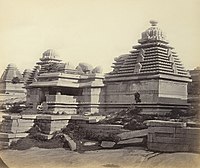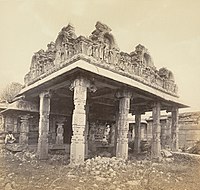Edmund David Lyon
| Edmund David Lyon | |
|---|---|
| Narození | 1825 |
| Úmrtí | 1891 (ve věku 65–66 let) |
| Povolání | fotograf |
| Některá data mohou pocházet z datové položky. Chybí svobodný obrázek. | |

Edmund David Lyon (1825–1891) byl britský fotograf a sloužil v britské armádě. Fotografoval na více než 100 archeologických nalezištích v Indii.
Fotografie
Později intenzivně fotografoval v jižní Indii a v roce 1865 otevřel svůj ateliér v Óttakamandu. Byl pověřen vládou Madrasu a vládou Bombaje (obě britské), aby v letech 1867–69 pořizoval fotografie archeologických nalezišť. V roce 1871 vydal knihu s názvem „Poznámky k sérii fotografií navržených k ilustraci starověké architektury západní Indie“, která obsahovala četné fotografie archeologických nalezišť i společenského života Indie 19. století.[1] Po odchodu do důchodu se věnoval komerční fotografii.[2] V listopadu 1867 byl jmenován generálním fotografem pro prezidentství Madrasu a od listopadu 1867 do srpna 1868 cestoval po Trichinopolech, Madurai, Tanjore, Halebid, Bellary a Vijayanagara Hampi výhradně za účelem fotografování chrámů a archeologických nalezišť.[3] Na žádost Madrasu a Bombaje během předsednictví British Raj vytvořil více než 300 fotografií starověkých památek a chrámů.[3] Také pořídil krajinářské fotografie v oblasti Coonoor.[4] Jeho fotografické práce vystavila Photographic Society of London v roce 1869 a byly dobře přijaty.[5]
Použití reflektorů
Některé z chodeb starověkých chrámů v jižní Indii jsou dlouhé 700 stop a pro zachycení detailů takových památek vytvořil Lyon řadu reflektorů.[3][5]
Spisovatel
Edmund David Lyon napsal dva romány, Signora (1883) a Irský sen: romance budoucnosti (1888) a několik knih o fotografii. [3]
Sbírky
Lyonova díla jsou mimo jiné zastoupena ve stálých sbírkách Muzea J. Paula Gettyho[6][7], Victoria and Albert Museum[8], Britské knihovny[9] nebo Muzea fotografického umění v kalifornském San Diegu[10] a několika dalších.
Galerie
Ruiny Vijianuggur, kónické chrámy, chrámy Hemakuta Hill Shiva v Hampi, Vijayanagara, 1868
Ruiny Vijianuggur, chrám Volkonda Ramachandra v Hampi, Vijayanagara, 1868
Stáje pro slony, 1865-1871
Arjunovo pokání, Mahabalipuram, Tamil Nadu, 1868
Odkazy
Reference
V tomto článku byl použit překlad textu z článku Edmund David Lyon na anglické Wikipedii.
- ↑ LUMINOUS, Lint. Captain Edmund David Lyon [online]. Luminous LInt [cit. 2022-02-08]. Dostupné online. (anglicky)
- ↑ Edmund David Lyon [online]. Oxford reference [cit. 2022-02-08]. Dostupné online. (anglicky)
- ↑ a b c d ARKNETIMAGES. Edmund David Lyon [online]. maddyworks.com [cit. 2022-02-09]. Dostupné online. (anglicky)
- ↑ Coonoor [online]. arts and culture [cit. 2022-02-09]. Dostupné online. (anglicky)
- ↑ a b EDMUND DAVID LYON (1825-1891) AND VARIOUS OTHER PHOTOGRAPHERS [online]. christies.com [cit. 2022-02-09]. Dostupné online. (anglicky)
- ↑ Longside Aisle. Ramisum Pagoda [online]. [cit. 2022-05-02]. Dostupné online. (anglicky)
- ↑ Interior of Peroor Temple. Nr. Coimbatore [online]. [cit. 2022-05-02]. Dostupné online. (anglicky)
- ↑ General view of the Ranganatha Temple at Srirangam [online]. [cit. 2022-05-02]. Dostupné online. (anglicky)
- ↑ Streevelliputtur [Srivilliputtur]. Tank and portions of old temple outside the town [online]. [cit. 2022-05-02]. Dostupné online. (anglicky)
- ↑ India and the Picturesque [online]. [cit. 2022-05-02]. Dostupné online. (anglicky)
Související články
Další významní fotografové 19. století v Indii:
Externí odkazy
 Obrázky, zvuky či videa k tématu Edmund David Lyon na Wikimedia Commons
Obrázky, zvuky či videa k tématu Edmund David Lyon na Wikimedia Commons
Média použitá na této stránce
From the source, Photograph of the sculptural detail at the base of the south gopura of the Ramalingeshvara temple at Tadpatri, Andhra Pradesh from the 'Photographs to Illustrate the Ancient Architecture of Southern India' collection, taken by Edmund David Lyon in c. 1868. The Ramalingeshvara temple is situated on the right bank of the River Penner. It was built in the early 16th century during the Vijayanagara period. The temple is surrounded by an enclosure wall entered through large gateways or gopuras on the south, west and north sides. Although unfinished these gopuras are covered with elaborate carvings consisting of architectural elements, such as niches covered by miniature temple towers and pilasters standing in pots. There are also sculptures representing figures of divinities, donors, maidens and rearing animals with riders as well as friezes, scrollwork, miniature animals and birds. The complex consists of two temples opening on a common hall.
Photographer: Lyon, Edmund David
Medium: Photographic print
Year created: 1868
Year published: 1868
Collection Photo 212/7(16) now at the British Library
Vijayanagara, the City of Victory, was the most powerful Hindu kingdom in Southern India from 1336 until 1565. It was founded on the bank of the Tungabhadra River by two brothers, Harihara and Bukka, formerly chieftains with the Delhi Sultanate. Vijayanagara flourished as a prosperous centre of Hindu art, culture and architecture, until the Battle of Talikota in 1565 when it was defeated by the armies of a coalition of neighbouring Muslim kingdoms.
The above Hemakuta hill monuments were misidentified as Jain temples in early 20th century.From the source,
Photograph of the relief sculpture of the Arjuna's Penance at Mamallapuram, taken by Edmund David Lyon around 1868, from an album of Photographs to Illustrate the Ancient Architecture of Southern India (vol. V).
Mamallapuram, a tiny village south of Madras, was a flourishing port of the Pallava dynasty during the 7th-8th centuries. The site, which covers several square miles, is famous for a series of monuments which date from the reign of Mamalla (c.630-68) and Rajasimha (c.700-728). Most of the monuments are rock-cut and were carved out of boulders and cliffs. This remarkable relief carving on two large boulders in the village dates from mid-7th century AD during the Pallava period. The scene has been interpreted as the Penance of Arjuna who is standing on one foot while Shiva is holding the magic weapon he hopes to obtain. The scene also represents the descent of the river Ganga to the earth, flowing through the matted hair of Shiva while animals and other beings watch the miracle. Originally water flowed along the cleft with the Naga figures.Photographer: Lyon, Edmund David
Medium: Photographic print
Year created: 1868
Year published: 1868
Collection Photo 212/6(40) now at the British Library
Vijayanagara, the City of Victory, was the most powerful Hindu kingdom in Southern India from 1336 until 1565. It was founded on the bank of the Tungabhadra River by two brothers, Harihara and Bukka, formerly chieftains with the Delhi Sultanate. Vijayanagara flourished as a prosperous centre of Hindu art, culture and architecture, until the Battle of Talikota in 1565 when it was defeated by the armies of a coalition of neighbouring Muslim kingdoms.Autor: Museum of Photographic Arts Collections, Licence: No restrictions
Artist: Edmund David Lyon
Artist Bio: British, c. 1829 - 1891
Creation Date: c. 1865-1871
Process: albumen print
Credit Line: Gift of the Catherine and Ralph Benkaim Collection








